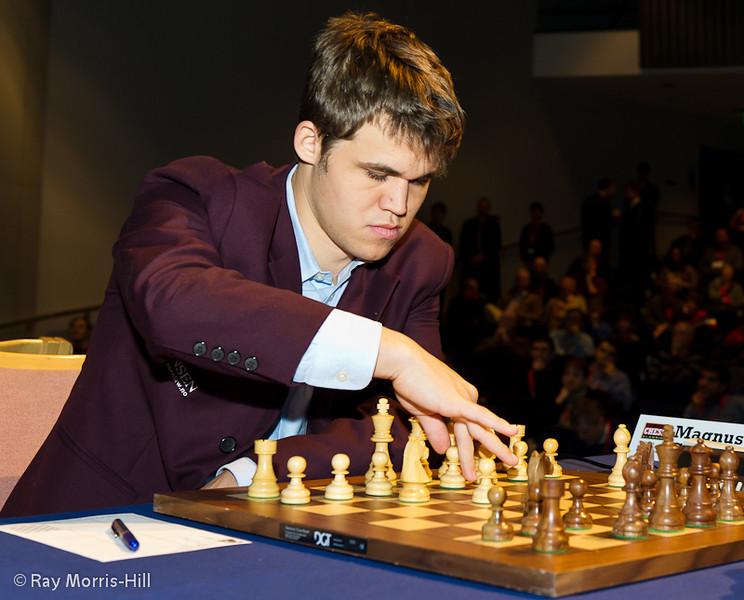
The Best Moves Never Played: Intuition 3
Today's article features a fighting game between Nakamura and Carlsen from the recent London Classic tournament. We will concentrate on few critical moments where intuition played a key role and explore how these two strong players with different styles approached and evaluated positions.
Let us stop at the first key moment. The opening was c3 Sicillian, which commentators labeled as "club player's" opening. Really, white did not achieve much and there are few lines that lead to a position where most players agree to a draw.
Here Hikaru was criticized for playing on the both wings simultaneously. It is well known dogma that one should attack on one flank and not try to do that on the both unless his position is overwhelmingly superior. After a3-b4 and h4 sequence white faces problems as his flank is underdeveloped. Hikaru's plan was to play Ra2-Rd2, g3 and Bb2 finishing his development.

Commenting on Nd:b4 sacrifice Nakamura states: "I guess subjectively after N:b4 it is just equal. I was actually surprised; I thought Magnus would try something a little bit sharper to keep the game complicated because I think after everything comes off the board I thought white was the only one who had some chances. In all these endgames black ends up with a bad bishop on f8."
In another words Nakamura claims that Carlsen's continuation was unambitious, to which Carlsen replies:
"The position is very complicated and I saw that with Nb4 I can bring clarity into the matter, eventually anyway. And I thought that I am going to be better in the resulting positions, but that was probably wrong evaluation, but also I wasn't so sure if Rc8 for example then you have to go Rc2 Qb6 and then g3. It doesn't look too bad for black, maybe a5." After what Hikaru mentioned that he hoped for a complicated position like this.
This is an excellent moment to stop and reflect on how these two very strong players approached this position. Hikaru looks for a messy position where each side had chances, while Carlsen seeks a position with clarity, where the plays are well-defined and where he thinks he has an advantage. Knowing players' styles and preference one could definitely predict that Nakamura will feel comfortable in any position where he attacks, while Carlsen wouldn't mind slightly better or equal endgame. Carlsen's intuitive evaluation of the resulting position is correct. As the position is quite rich and it is only black who can play for a win there. In an alternative continuation Rc8 shown below as a line the position remains unclear.
The next few moves were more or less forced and we arrive at the position after move 22.

Kramnik, who had a day off that round, and Aronian liked very much the resulting endgame for Carlsen. Here we have another two of the best endgame players in the world evaluating black's position positively. For a piece, black has two passed pawns on the queenside and the two bishops. Moreover, white pieces are poorly coordinated. Black can have different approach to the position: playing slowly with h6, for example as suggested by Kramnik, or taking the knight on f3 and messing up white's pawns structure on the kingside as was played in the game. After h6, black will maintain the strong bishop on b7, create a room for the king and restrict white knight and bishop from the g5 square. "I was just thinking that I would have a safe advantage with B:f3." - Carlsen states but adds that "maybe they [Kramnik and Aronian] were onto something".
In fact the computer likes h6 move better than B:f3. It seems that black will have more winning chances with the bishop on b7. It is very hard to compare the resulting positions as the material is irregular; however, I think that the drive to clarify the position even further cost Carlsen a certain advantage.
"I actually missed that I couldn't just go and take the bishop [look at the line of the 24th move], I somehow thought that the knight would be trapped on b1, which isn't by any stretch." It seems to me that Carlsen saw this win of the bishop when he took the knight on f3 and evaluated the bishop exchange for the knight as extremely favorable for him. It seems that Carlsen chose B:f3 over h6 because of miscalculation of one of the lines. But there is a problem of chicken and egg: whether he liked the B:f3 more and hence didn't bother to calculate the resulting lines precisely, or he calculated the lines first that looked favorable and chose B:f3 move. In the first instance his decision would be of intuitive nature, while in the second it would be pure miscalculation that has nothing to do with intuition. In the end Carlsen agrees and jokes at the same time that "not giving up the bishop was the right way to go. But that is the way we - young guys play chess -way too superficially".
So really the critical position was on the move 22. and after B:f3 white was already fine and in the game even managed to play for a win. Carlsen defended very well and the game ended up in a draw.
We will continue with the series of Intuition in the next article.






